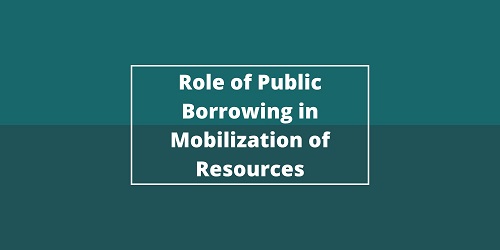Table of Contents
Role of Public Borrowing in Mobilization of Resources:
The Government may mobilize the savings of the community through the device of public borrowings. If Government can tap sufficient public savings through voluntary loans, it will partially solve the problem of financing public investment expenditure by a non-inflationary method. However, such voluntary savings will be anti-inflationary only if buyers of government securities reduce their spending in order to buy them, but the diversion of saving from other liquid assets to government securities will not have an anti-inflationary effect.
Again, if people subscribe government loans out of their past savings, then public borrowing will have little effect on restricting consumption, but if they are financed out of current income, it will definitely lead to a curtailment of consumption expenditure. However, when large borrowings are made by the government; some decrease in private consumption is bound to take place. It thus takes away a part of the additional purchasing power of the people and reduces inflationary pressure on the economy.
Arguments in Favor of Public Borrowing:
Besides, the significance of public borrowings as a source of development finance lies in the following facts:
(1) Very large resources are needed for economic development which can not be raised by taxation alone.
(2) Too much taxation creates dissatisfaction among the people while public debt has no such defect.
(c) Public debt used for productive purposes creates income-yielding assets.
(d) Public debt imposes a burden on future generations who are the main beneficiaries.
(e) Financing economic development through public debt is anti-inflationary.
Limitations:
(1) In many under-developed countries, organized money and capital markets are non-existent, and in these economies where such markets exist, they constitute a very small proportion of the total money market of the country. Again, there may not be any organic relationship between the organized and unorganized sectors of the money market. Hence, sufficient funds may not be available.
(2) The rate of interest may not be very effective for mobilizing saving in an economy where the per capita saving is small, and where savings of the richer class tend to be diverted into investment in real estate and holding of gold.
(3) If Government competes with private enterprises for funds, interest rates may be forced up with a disincentive effect on private investment.
(4) Public debt increases inequalities in wealth in society.
(5) Public debt gives rise to unearned income and enables a particular class of people to live on this sort of income.
Justification:
Unlike war borrowing which is unproductive, borrowing for investment in development projects leads to the building up of assets that yield returns to the economy. If the rate of growth of public borrowing is accompanied by corresponding increases in the rate of asset creation, the burden of public debt would be less onerous. If the borrowed funds are used for assets creating public projects, the income of the nation is bound to rise along with the rise in government obligations. The cost or the burden should be offset by the benefits that the debt creation confers. Thus rising internal public debt may have an important contribution to increasing the national income of a country. Thus, public borrowing is an important source of development finance and an instrument that can be used for diverting resources from unproductive channels such as gold, jewelry, real estate, and ostentatious articles to productive channels, such as development projects like power generation, irrigation, works, roads, railways, etc.
In view of the utmost significance of public borrowings as a tool for the mobilization of resources for the economic development of under-developed countries, there are some who have argued that, if sufficient funds are not forthcoming in the form of voluntary loans, the government may have to resort to compulsory borrowing for the mobilization of resources for capital formation. Compulsory public borrowing is, therefore, justified where taxation and voluntary borrowing fail to bring adequate funds for financing development projects. To put it in the words of Nurkse, “Since individuals are interested not only in their consumption but also in the size of their assets holding, there is a case for forced loans as an alternative to taxation.”
A U.N. report points out the manner in which public borrowing should be utilized, it said: “Types of development suitable to be financed by borrowing are instances where publicly owned assets are created, where profitable returns are expected from specific projects, where development is not of long term character and will result in an increase in productivity in the immediate future, where the development is such that charges, fees, or specific taxes can be imposed upon the beneficiaries so that the original debt incurred for construction can be serviced from fees.”
Government borrowing must also be viewed from the point of view of the tax-payer. While the taxpayer feels some financial loss, the lender to the Government feels that he is building up his assets and this gives him psychological satisfaction whereas heavy taxation distorts initiative and enterprise.
Since the mobilization of resources through public borrowings has every justification for financing development projects, the following suggestions are made to raise the resources through public borrowings.
(1) Financial institutions should be developed in both urban and rural areas with a view to include the habit of thrift among the people and mobilize these savings for productive purposes.
(2) Suitable techniques of borrowing should be devised so as to attract savings even from marginal savers.
(3) Public institutions should be highly decentralized, they should offer attractive terms to serves and should provide varied types of securities.
(4) Government securities should have better marketability and competitive rates with private issues.
(5) Government securities should have special features such as ready convertibility to each acceptance of government securities at par for tax payments, etc.
(6) Finally, there must be confidence in the stability of the Government and there should be no threat of inflation.









Comments (No)